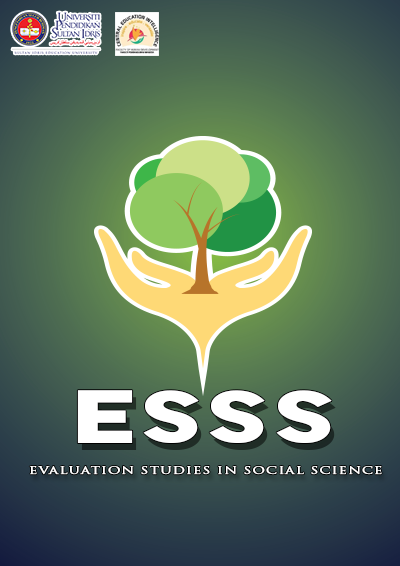TVET Students’ Perception towards Online Distance Learning (ODL) during Pandemic COVID-19: Mental Health Perspective
DOI:
https://doi.org/10.37134/esss.vol2.sp.11.2021Keywords:
COVID-19, TVET, online distance learning, mental health, studentsAbstract
The COVID-19 pandemic has affected the education sector, primarily in vocational education. The pressure for practical assessment solutions of TVET students during a pandemic is the biggest challenge. Social change conditions significantly contribute to increased health problems, including mental and psychological illnesses such as mental disorders. This study aimed to identify the frequency of mental health, TVET students' perceptions and the relationship to online learning perceptions during the COVID-19 pandemic. The design of this study is quantitative survey research. Data was collected through a questionnaire form created on Google Form consisting of 41 questions. The questionnaire used a DASS-21 scale for the 21-item depression, anxiety, stress item and a Likert scale for students’ perceptions of online learning. The total sample of respondents was 152 TVET students, with a response rate of 60.3%. This study was analyzed using Statistical Package for the social sciences (SPSS) version 23.0 to calculate the frequency, mean, percentage, standard deviation, t-test correlation and ANOVA test. The study results showed the frequency of mental health of TVET students at the level of disagreement (M = 1.05). The highest frequency of DASS-21 is Depression (M = 10.9). Respondents agreed (M = 3.51) that students' perceptions of online learning affected them. The highest frequency of online perception learning is factor three (M = 3.63), and the lowest frequency is factor two (M = 3.30). Finally, the study results found that a correlation analysis had no direct positive relationship (r = .177) between mental health and perceptions of online learning during the COVID -19 pandemic. Therefore, there is a need to consider educational policies towards a new norm in education to improve the mental health and perceptions of TVET students towards online distance learning.
Downloads
References
Ag-Ahmad, N. (2020). Open and distance learning (odl): Preferences, issues and challenges amidst Covid-19 pandemic. Journal of Creative Practices in Language Learning and Teaching (CPLT), 8(2), 2020.
Bączek, M., Zagańczyk-Bączek, M., Szpringer, M., Jaroszyński, A., & Wożakowska-Kapłon, B. (2021). Students’ perception of online learning during the COVID-19 pandemic. Medicine, 100 (7), e24821. https://doi.org/10.1097/md.0000000000024821
Cullen, W., Gulati, G., & Kelly, B. D. (2020). Mental health in the COVID-19 pandemic. Qjm, 113(5), 311–312. https://doi.org/10.1093/QJMED/HCAA110
Giordano, L., Cipollaro, L., Migliorini, F., & Maffulli, N. (2020). Impact of Covid-19 on undergraduate and residency training. Surgeon, November. https://doi.org/10.1016/j.surge.2020.09.014
Hasan, N., & Bao, Y. (2020). Impact of “e-Learning crack-up” perception on psychological distress among college students during COVID-19 pandemic: A mediating role of “fear of academic year loss.” Elsevier, 118(January).
Irawan, A. W., Dwisona, & Lestari, M. (2020). Psyhological impacts of students on online learing during the pandemic Covid-19. Konseli: Jurnal Bimbingan dan Konseling (E-Journal), 07(1), 53–60.
Jena, P. K. (2020). Impact of pandemic COVID-19 on education in India. International Journal of Current Research (IJCR), August. https://doi.org/10.31235/osf.io/2kasu
Khairuddin, Z., Arif, N. N. A. N. M., & Khairuddin, Z. (2020). Students’ readiness on online distance learning (ODL). Universal Journal of Educational Research, 8(12), 7141–7150. https://doi.org/10.13189/ujer.2020.081281
Krejcie, R. V., & Morgan, D. W. (1970). Determining sample size for research activities. Educational and Psychological Measurement, 30(3), 607-610.
Lovibond. (1995). Manual For The Depression Anxiety & Stress Scales. Psychology Foundation, 2, 1–2.
Osman, W. N., Radzuan, K., Zulhumadi, F., & Mohd Nawi, M. N. (2020). Research on the potential for academicians to work from home: Research in a Malaysian public university. Journal of Information System and Technology Management, 5(19), 93–103. https://doi.org/10.35631/jistm.519008
Pascoe, M. C., Hetrick, S. E., & Parker, A. G. (2020). The impact of stress on students in secondary school and higher education. International Journal of Adolescence and Youth, 25(1), 104–112. https://doi.org/10.1080/02673843.2019.1596823
Salleh, N. F. (2020). Pandemik coronavirus (covid-19): Pembelajaran dan pengajaran secara atas talian suatu keperluan di Malaysia. https://www.researchgate.net/publication/342886967.
Shamzaeffa, S., & Kevin Tan, C. H. (2016). Hubungan antara tahap kesihatan mental dan prestasi pelajar sarjana muda : Satu kajian di Universiti Utara Malaysia. Jurnal Sains Kesihatan Malaysia, 14(1), 11–16. http://ejournal.ukm.my/jskm/article/view/12264/3884
Siddiqui, N. A., Fatima, S., Taj, F. B., Shahid, A., & Moosa, Z. A. (2020). Depression among undergraduate medical and engineering students: A comparative study. Pakistan Journal of Medical Sciences, 36(5), 1096–1099. https://doi.org/10.12669/pjms.36.5.1858
Tharumalay, R. D., Md. Din, N. S. B., & Ahmad, M. (2020). The effects of circadian rhythm disruption towards metabolic stress and mental health: A review. Jurnal Sains Kesihatan Malaysia, 18(01), 47–61. https://doi.org/10.17576/jskm-2020-1801-07





